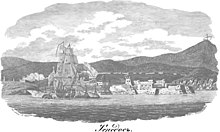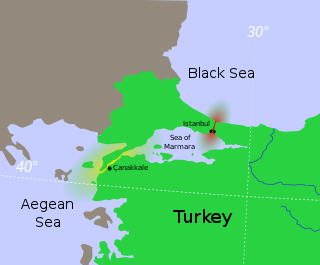
The Bosporus or Bosphorus Strait is a natural strait and an internationally significant waterway located in Istanbul, Turkey. The Bosporus connects the Black Sea to the Sea of Marmara and forms one of the continental boundaries between Asia and Europe. It also divides Turkey by separating Asia minor from Thrace. It is the world's narrowest strait used for international navigation.

Imbros, officially Gökçeada since 29 July 1970, is the largest island of Turkey, located in Çanakkale Province. It is located in the north-northeastern Aegean Sea, at the entrance of Saros Bay, and has the westernmost point of Turkey. Imbros has an area of 286.8 km2 (110.7 sq mi), and has some wooded areas.

Tenedos, or Bozcaada in Turkish, is an island of Turkey in the northeastern part of the Aegean Sea. Administratively, the island constitutes the Bozcaada district of Çanakkale Province. With an area of 39.9 km2 (15 sq mi), it is the third-largest Turkish island after Imbros (Gökçeada) and Marmara. In 2022, the district had a population of 3,120 inhabitants. The main industries are tourism, wine production and fishing. The island has been famous for its grapes, wines and red poppies for centuries. It is a former bishopric and presently a Latin Catholic titular see.

Jaffa Gate is one of the seven main open gates of the Old City of Jerusalem.

The Citadel of Aleppo is a large medieval fortified palace in the centre of the old city of Aleppo, northern Syria. It is considered to be one of the oldest and largest castles in the world. Usage of the Citadel hill dates back at least to the middle of the 3rd millennium BCE. Occupied by many civilizations over time – including the Greeks, Armenians, Romans, Byzantines, Ayyubids, Mamluks and Ottomans – the majority of the construction as it stands today is thought to originate from the Ayyubid period. An extensive conservation work took place in the 2000s CE by the Aga Khan Trust for Culture, in collaboration with Aleppo Archeological Society. Dominating the city, the Citadel is part of the Ancient City of Aleppo, an UNESCO World Heritage Site since 1986 CE. During the 2010s, the Citadel received significant damage during the lengthy Battle of Aleppo. It was reopened to the public in early 2018 CE with repairs to damaged parts underway, though some of the damage will be purposefully preserved as part of the history of the citadel. The citadel was damaged by the 2023 Turkey–Syria earthquake.
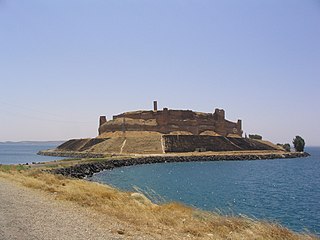
Qal'at Ja'bar is a castle on the left bank of Lake Assad in Raqqa Governorate, Syria. Its site, formerly a prominent hill-top overlooking the Euphrates Valley, is now an island in Lake Assad that can only be reached by an artificial causeway. Although the hilltop on which the castle sits was possibly already fortified in the 7th century, the current structures are primarily the work of Nur ad-Din, who rebuilt the castle from 1168 onwards. Since 1965, several excavations have been carried out in and around the castle, as well as restoration works of the walls and towers. The castle was a Turkish exclave between 1921 and 1973.

The Fortezza is the citadel of the city of Rethymno in Crete, Greece. It was built by the Venetians in the 16th century, and was captured by the Ottomans in 1646. By the early 20th century, many houses were built within the citadel. These were demolished after World War II, leaving only a few historic buildings within the Fortezza. Today, the citadel is in good condition and is open to the public.

Meydancık Castle is a castle ruin in Mersin Province, Turkey. The original name was Kirshu and the name of the ruin during Ottoman times was Beydili Kale.
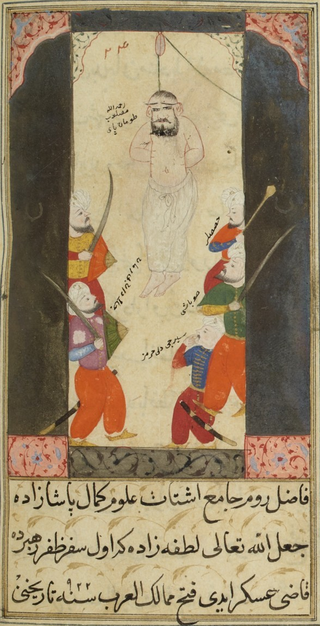
The capture of Cairo was the final major engagement of the Ottoman Mamluk war of 1516-1517. The city of Cairo, the capital of the Mamluk Sultanate, was sacked and fell into the hands of the Ottoman forces led by Sultan Selim I during the 27-30 January 1517. Following Cairo's fall and the subsequent execution of the last Mamluk Sultan and member of the Abbasid dynasty: Tuman Bay II, the Mamluk Sultanate was absorbed into the expanding Ottoman Empire. Following its conquest, Cairo saw its status being reduced from the once prosperous capital of the Mamluk Sultanate to a provincial city governed from Constantinople. The economic decline present from the later years of the Mamluk Sultanate would continue under Ottoman rule, with the country being increasingly burdened by taxation by the imperial government and its status as a military base with the purpose of launching further expansion into surrounding lands.

The Castle of Kars is a former fortification located in Kars, Turkey. It is also known under the name İç Kale.

Bozcaada is a municipality in Çanakkale Province, Turkey. It is the seat of and coterminous with the Bozcaada District, which covers the North Aegean island of Bozcaada and a number of islets around it. Its area is 37 km2, and its population is 3,120 (2022). Its mayor is Hakan Can Yılmaz (CHP), and its kaymakam is Muhammet Mustafa Kara.

Kassiopi Castle is a castle on the northeastern coast of Corfu overseeing the fishing village of Kassiopi. It was one of three Byzantine-period castles that defended the island before the Venetian era (1386–1797). The castles formed a defensive triangle, with Gardiki guarding the island's south, Kassiopi the northeast and Angelokastro the northwest.

The Old Fortress of Corfu is a Venetian fortress in the city of Corfu. The fortress covers the promontory which initially contained the old town of Corfu that had emerged during Byzantine times.
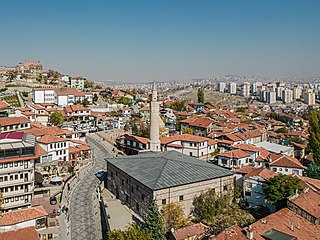
Aslanhane Mosque is a 13th-century mosque in Ankara, Turkey.

The fortress of New Navarino is an Ottoman fortification near Pylos, Greece. It is one of two castles guarding the strategic Bay of Pylos, on which it sits; New Navarino is located in the southern entrance of the bay, while the northern entrance is guarded by the 13th-century Old Navarino castle, built by the Crusaders of the Principality of Achaea. In juxtaposition with the latter, New Navarino is often known simply as Neokastro or Niokastro.

The siege of Santa Maura took place on 21 July – 6 August 1684 between the forces of the Republic of Venice and the Ottoman Empire, and was the opening battle of the Sixth Ottoman–Venetian War. From his base at Corfu the Venetian commander-in-chief, Francesco Morosini, led a fleet of 38 galleys, 8 galleasses and several auxiliary vessels to besiege the Fortress of Santa Maura on the island of Lefkada, that was under Ottoman rule. The besieging forces were swelled by Greek levies and volunteers from the Ionian Islands. The siege lasted until 6 August, when the commander Bekir Agha, bowing to pressure from the 500 Albanians and 200 Greeks in the fortress garrison, surrendered to the Venetians.

Gülek Castle is a medieval castle in Mersin Province, Turkey.

The Castle of Santa Maura is a fortress on the northeastern tip of the Greek island of Lefkada. The castle began as a small fortification in c. 1300 to control access to the island, before it was expanded to become a walled town and the island's capital by the early 15th century. The Ottoman Empire took possession in 1479, and a century later rebuilt and enlarged it, giving it largely its present shape. A sizeable town grew outside the castle walls by the 1670s.
The Harran Castle or Harran Citadel is a castle ruin in Harran, Turkey. Most of the present structure dates to the Ayyubid Sultanate c. 1200 but the castle is substantially older. Its exact founding date is unknown but it appears to have been built at some point during the time Harran was under Byzantine rule and was originally a palace.

The Castle of Arta is a medieval fortification in the city of Arta in western Greece.


